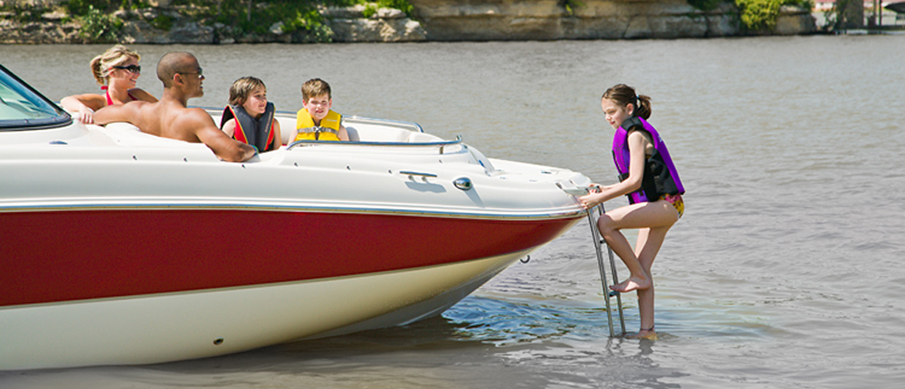
Basic Ladder Styles & Features
 |
Description:
|
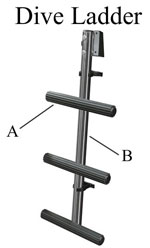 |
Description:
|
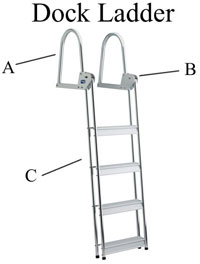 |
Description:
|
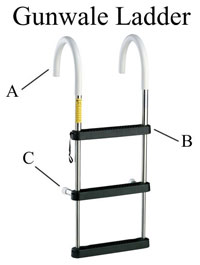 |
Description:
|
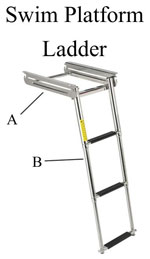 |
Description:
|
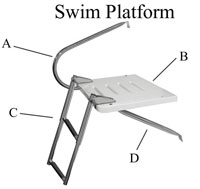 |
Description:
|
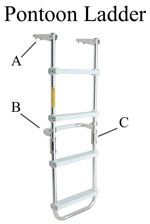 |
Description:
|
Choosing the Right Ladder Size For Your Boat
When you're floating in the water, only your head and shoulders are above the surface. This is an important consideration when using a ladder to reboard your boat. If the ladder doesn't extend deep enough into the water, you may have to bring your leg up to your chest just to get on that first rung. As a result, it is very important to choose a ladder that will extend two or three rungs below the water’s surface (about 2 - 3 feet).
To determine the overall height of the ladder you need, measure the height of the freeboard on your boat and then add an extra 2 to 3 feet for ladder submersion. For mounted ladders, also take into consideration where the ladder will be mounted on your boat. You’ll need to allow for proper ladder submersion, while also mounting high enough up the freeboard in order to make reboarding easy.
Pro Tip: If reboarding from the side of your boat, choose a ladder with standoffs that rest against the hull. This adds rigidity and stability to the boat ladder. Ladders without standoffs in a side-boarding situation can flex and float underneath the boat, making them difficult to climb.
Aluminum vs. Stainless Steel Boat Ladders
| Aluminum Boat Ladders | Stainless Steel Boat Ladders |
|---|---|
| Most popular | Best in class |
| Less expensive | Sturdy and reliable |
| Lightweight, easy to stow and deploy | Higher corrosion resistance |
| Lighter design can flex under heavier weights | Slightly heavier, but extra heft prevents flexion |
General Boat Ladder Mounting Tips
Boat ladders come in many different shapes, sizes, and styles. Just as there are hundreds of types of boats, there are hundreds of kinds of boat ladders. As a result, permanently mounting a ladder to your boat is different in every situation. There are, however, a few generalized guidelines to consider, regardless of your ladder mounting situation.
- Consider having the ladder professionally installed. Having your ladder professionally installed assures it’s done properly and safely. Also, professional installation is a safeguard against warranty issues should the ladder fail due to a defect.
- Read the instructions. Mounting and assembly instructions are included with your boat ladder. If you intend to install the ladder yourself, read and follow the instructions so the ladder is installed properly and won't fail you down the road.
- Cutting and drilling will be required. Depending on where the ladder is mounted, you will have to drill into your deck or hull. Pre-drilled holes on the ladder may also need a little extra drilling in order to allow the bolts to fit properly. Additionally, ladder tubes may need to be cut down to match the curve of your hull.
- Install a backing plate for additional support. When someone is climbing your boat ladder, a large amount of stress is being exerted over a small area of the hull. This can cause the hull to buckle or the screws to loosen. A metal backing plate helps mitigate such issues by reinforcing the hull where the ladder is mounted.
- Measure the area and position your ladder before drilling. Since each mounting situation is different, measure your intended mounting area, position your ladder, and mark where you are going to drill ahead of time. Make sure everything is positioned correctly and as you want it before drilling any holes.
Safety Tip: Periodically check the mounting and assembly hardware and retighten as necessary. Vibration from the motor and regular use may cause hardware to loosen over time.
Permanent vs. Temporary Mounted Ladder
| Permanently Mounted Ladder | Temporarily Mounted Ladder |
|---|---|
| Always at the ready | Many models fold flat for compact stowage |
| Doesn't take up storage space | Lightweight and easy to deploy |
| Can be quickly deployed in an emergency | Many models can also mount permanently |
| Cannot be deployed when the boat is moving | Easier to keep dry and prevent corrosion |
Is Mounting Hardware Included?
One of the most common questions asked when selecting a boat boarding ladder is whether or not the mounting hardware is included. The answer depends on the manufacturer and the ladder. In most cases, assembly hardware and special mounting brackets (if required) are included. However, it is common to have to go to a marine supply store and purchase the actual hardware needed to physically mount the ladder to your boat. This mounting hardware should only be a couple of nuts, bolts, and washer sets.
Every boat is unique, and so are your ladder-mounting needs. Are you mounting to the transom? Is it a flat or curved transom? Are you using backing? All of these considerations, and more, help determine the size and type of hardware you’ll need. Because of the many factors and variations among boats and boat ladders, there is not really a “one-kit-fits-all” mounting solution.
What to do When Replacing an Existing Ladder?
Replacing a mounted boat ladder is a tricky scenario. In an ideal world, you can find either the same model or one with an identical mounting pattern and use the same holes. If you know the brand and model number of the ladder being replaced, these factors will help your sales representative determine if a new ladder is available.
However, if the ladder is more than 10 years old, chances are that model is no longer available. You may be able to find a comparable mounting pattern from the same brand, but the more likely scenario is you'll have to patch the mounting holes in your boat, replace the backer plate (or add one), and then remount using the new boat ladder.
Boat Ladder Care and Maintenance
Though they are not immune to it, both aluminum and stainless steel boat ladders are designed to resist corrosion. Salty marine air, submersion in water, and marine life can eventually cause rust, but regular ladder cleaning and maintenance can help maintain your ladder’s luster and rung life for years to come. To care for your boat ladder, regularly implement the following steps.
- Rinse the ladder after use. After you're done on the lake for the day give your ladder a quick rinse with the hose to remove any corrosive elements.
- Regularly clean your ladder. Just like cleaning your car or washing your favorite boat, periodically cleaning your boat ladder with soap or a mild abrasive will reduce the risk of corrosion.
- Stow the ladder out of water when not in use. When you're done boating for the season, remove the ladder and store it in a dry place out of the elements.


